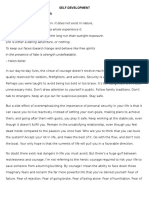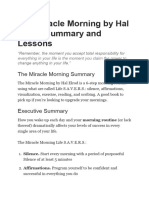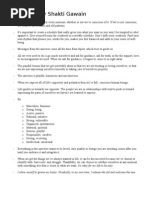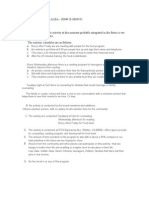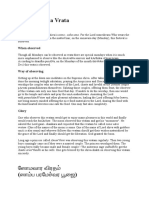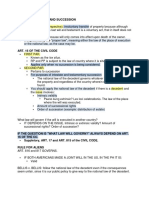100%(1)100% found this document useful (1 vote)
Memorization Techniques
Memorization Techniques
Uploaded by
Emerson Salazar1. The document describes several memory techniques including the link method, story method, loci method, peg system, mind maps, and the Roman room technique.
2. The Roman room technique involves imagining a familiar room and assigning numbers to different locations within it like walls and corners. Information is memorized by associating items with the numbered locations.
3. Using senses, emotions, and vivid imagery when placing items in the imaginary locations can improve memory according to the technique. With practice, a person can integrate more information and recall it sequentially using this method.
Copyright:
© All Rights Reserved
Available Formats
Download as PDF, TXT or read online from Scribd
Download as pdf or txt
Memorization Techniques
Memorization Techniques
Uploaded by
Emerson Salazar100%(1)100% found this document useful (1 vote)
1. The document describes several memory techniques including the link method, story method, loci method, peg system, mind maps, and the Roman room technique.
2. The Roman room technique involves imagining a familiar room and assigning numbers to different locations within it like walls and corners. Information is memorized by associating items with the numbered locations.
3. Using senses, emotions, and vivid imagery when placing items in the imaginary locations can improve memory according to the technique. With practice, a person can integrate more information and recall it sequentially using this method.
Original Description:
Memorization Techniques
Copyright
© © All Rights Reserved
Available Formats
PDF, TXT or read online from Scribd
Share this document
Did you find this document useful?
Is this content inappropriate?
1. The document describes several memory techniques including the link method, story method, loci method, peg system, mind maps, and the Roman room technique.
2. The Roman room technique involves imagining a familiar room and assigning numbers to different locations within it like walls and corners. Information is memorized by associating items with the numbered locations.
3. Using senses, emotions, and vivid imagery when placing items in the imaginary locations can improve memory according to the technique. With practice, a person can integrate more information and recall it sequentially using this method.
Copyright:
© All Rights Reserved
Available Formats
Download as PDF, TXT or read online from Scribd
Download as pdf or txt
100%(1)100% found this document useful (1 vote)
Memorization Techniques
Memorization Techniques
Uploaded by
Emerson Salazar1. The document describes several memory techniques including the link method, story method, loci method, peg system, mind maps, and the Roman room technique.
2. The Roman room technique involves imagining a familiar room and assigning numbers to different locations within it like walls and corners. Information is memorized by associating items with the numbered locations.
3. Using senses, emotions, and vivid imagery when placing items in the imaginary locations can improve memory according to the technique. With practice, a person can integrate more information and recall it sequentially using this method.
Copyright:
© All Rights Reserved
Available Formats
Download as PDF, TXT or read online from Scribd
Download as pdf or txt
You are on page 1/ 5
1.
Connect & Link (The Link Method)
As the name suggests, this memorization technique involves creating associations between items
in a list and assigning images to each connection to help you memorize better. For instance, your
accounting exam is tomorrow and you need to memorize which items fall under the Current Asset
section of a balance sheet (Cash, Inventories, Accounts receivable, Prepaid expenses).
You can create associations as below:
I currently don’t have any cash to buy any inventory
To buy the inventory, I shall collect my accounts receivable that my friends owe me
If I collect the accounts receivable, it should be enough because I already have
prepaid expenses from last year to count towards the purchase
2. Make a Story (The Story Method)
This approach is really similar to the Link Method. While you create a bunch of different images
between each two items using the Link Method, you combine everything into one big picture with
the Story Method. This technique helps you memorize the sequence of the images and hence the
order of the items. Using the accounting example, it would look like this:
I currently don’t have any cash to buy any inventory. Maybe I should collect my accounts
receivable that my friends owe me. After I get my money back, it should be enough because I
already have prepaid expenses from last year to count towards the purchase.
3. Associate Objects with Familiar Locations (The Loci Method)
You can use this memorization method by associating terms or list items with familiar locations.
Let’s say, for your Greek myth exam, you have to memorize a list of symbols of each of the
Olympian deities. Take Aphrodite’s symbols/characteristics for example: Eros/winged cupid, myrrh
tree, apple tree, and goose.
First, pick a place that you’re very familiar with, say your house. Imagine that you walk into your
front yard, and find a winged cupid sitting perched on top of a ginormous myrrh tree. As you enter
the house and into the kitchen, you see a five-feet-tall goose devouring your dinner leftovers from
the fridge. Aghast, you run out of the kitchen into the living room, only to find that an apple tree is
planted in the middle of it, and apples strewn all over your couch.
Get the idea right? Make these images as absurd, comical, sensory (e.g. can incorporate sounds,
smells, tastes), and vivid as possible for best results. This is a centuries-old method started by
ancient Romans and is still used today by many World Memory Champions.
4. Peg Objects to a Number (The Peg System)
This is useful system for memorizing lists in a particular order. There are two steps:
Step 1 requires you to memorize words that are easy to associate with numbers (e.g. 1 to 5). You
can use words that rhyme with the number, or shapes that resemble the number. For example:
. Sun or Bun
. Zoo
. Free
. More
. Hive
Once this peglist is memorized, you can now associate the words with the list of objects you need
to memorize. For example, you need to memorize the five successive stages of history as
identified by Marx and Engel: Primitive Communism, Slave Society, Feudalism, Capitalism, and
Socialism.
. In the primitive times only a little after the sun was created, people shared their buns
(food) in a communal setting.
. Slaves were treated worse than animals in the zoo
. It was not free to become a feudal lord. The price was to own some land.
. Those capitalist pigs want more and more money!
. Bees are social insects, so they live together in a hive.
If you need to know what the fourth stage on the list was, all you need to remember is more, and
then you’ll remember capitalism. Another advantage to this memorization technique is that once
you memorize the peglist, you can use it repeatedly for other lists.
5. Draw a Mind Map
For memorizing any structured concepts or information, mind maps work well by laying out the
structure and making the flow of information more clear. If you are struggling to memorizing the
whole decision making process in the correct order for the short answer section on your upcoming
psychology exam, or anything similar, you should try out this method!
6. The Roman Room (Memory Palace)
“When this memorization technique is practiced to maturity, this process becomes natural. It is
difficult to overstate how this technique can improve your memory.”
Now that you have been introduced to some basic techniques to help you remember things, it’s
time to put it all together. Let’s make a comparison before we begin. Try remembering the following
words in order:
Textbook, shoulder, computer, picture frame, refrigerator, molecule, pen, cloud, telephone, cat
Do your best. It is not an easy task, particularly because there are no obvious associations to make
between the words to help recall, let alone ordered recall.
Now, the Roman Room is a technique that could be applied to a list of words like this, or any
information once you get well practiced at creating visual depictions of abstract words. The
technique goes like this: bring to mind a room that you are very familiar with. This can be anything
from your current bedroom, a bathroom, a living room, anything that you are very familiar with and
therefore comes to your mind in a detailed depiction.
As you walk into the room, the corner over your left shoulder is number 1. Then, moving clockwise
round the room, the next wall is number 2. The next corner is number 3. And so on, so that the
corner that is number 5 is opposite of the corner that is number 1, and the wall that is number 2 is
opposite the wall that is number 6.
The Roman Room
There are 8 numbers so far: there are 4 corners and 4 walls in a typical room. In addition to these 8
distinguished locations, number 9 will be the floor and number 10 will be the ceiling.
It is important that these enumerated locations become automatically identifiable. To practice, take
ten pieces of paper, numbered 1 through 10, and draw them at random. When you draw a number,
identify that location in your mental room as quickly as possible. So, for example, if you drew the
number 4, you should see the wall immediately across from the door (since location 1 is the corner
behind your left shoulder, location 2 is the wall to your left, and location 3 is the next corner moving
clockwise). When you identify this location, think about all that is in that location usually. This may
be where you store some of your books and one of the walls your bed touches, as is the case in
my bedroom. This number-drawing exercise is important for two reasons: it important that you are
able to quickly identify what corners, walls, ceiling and floor corresponds to which number in the
numerical sequence, and revisiting your mental room is helpful for giving your mental
representation of your room more life.
Next, with your room clearly drawn out in your mind, we can use the room to help commit
information to memory. An excellent method is by incorporating into the room objects that are
symbolically representative of the information you want to remember. The list I provided earlier is
easy to use because they are all objects: you can place a textbook in the location number 1 (which
is behind the door in my room, so I imagine it as a door-stop), lean on location number 2 with your
shoulder (because it is the wall on your left-hand side), and so on.
What is important is that you SEA to see. That is, incorporate Senses, Emotions, and Action into
your memory. For example, placing the textbook as a door-stop, I imagine seeing and feeling the
textbook, feeling my frustration that the door handle has been making holes in my wall, and
imagine myself choosing the book and putting it in place.
This level of engagement with memories takes time, but it makes their recall more efficient and
reliable because you have created a mental environment that allows for greater integration of
memory. So, in the end, you will save time.
Some rooms you can use as temporary storage: remembering a phone number, grocery list, etc.
Other rooms you can use for permanent storage: important life lessons you have learned or other
useful information that you may want to call on later.
As you become better at using this technique, you can incorporate more and more rooms. By
connecting the rooms in a memorable order, such as story, you expand the amount of information
you can consolidate using this technique (ex. bedroom, bathroom, living room, mom’s bedroom,
and so on). Each new room continues the count, using the same over the left shoulder, clockwise
routine: 1, 10, 11, 20, 21, 30, etc. So, not only can you remember information, you can remember
the information sequentially.
When this technique is practiced to maturity, this process becomes natural. It is difficult to
overstate how this technique can improve your memory.
Some of these techniques may work for you, and some may not. Next time you have to regurgitate
a textbook for an exam, try these out! Stay tuned for more helpful study tips from .
By the way, 95% of university students improved their grades after using OneClass for course
notes and study contents
Mnemosyne, the personification of memory in Greek
mythology, was the daughter of Gaia (goddess of Earth) and
Uranus (god of the sky) and, quite interestingly, the mother of
the nine Muses. These latter, in turn, were the goddesses of the
inspiration of literature, science and the arts. They were
considered the source of knowledge, related orally for
centuries in the ancient culture that was contained in poetic
lyrics and myths.
Mnemosyne, is, you might have guessed, the source of the word mnemonic. The notion that
memory and creativity are two sides of the same coin sounds counter-intuitive, but this notion has
been around as far back as when Socrates and Plato were busy laying down the foundations of
Western philosophy. Remembering and creativity, especially in this modern day and age, seem like
opposite, not complementary, processes. But the idea that they are one and the same is indeed
quite old, and was once even taken for granted. The Latin root inventio is the basis of two words in
our modern English vocabulary: inventory and invention. And to a mind trained in the art of
memory, those two ideas were closely linked. Invention was a product of inventorying.
“Where do new ideas come from if not some alchemical blending of old ideas?”, asks Joshua Foer
in “Moonwalking with Einstein.” In order to invent, one first needs a proper inventory, a bank of
existing ideas to draw on. Not just an inventory, but an indexed inventory. One needs a way of
finding just the right piece of information at just the right moment, and this was especially true
before advances in technology that externalized knowledge. In other words, it takes knowledge to
gain knowledge, and it takes knowledge to remember new knowledge much more effectively, as I
pointed out in Memory Tip #7.
“It turns out the seeds of remembering or forgetting are laid from the very first time you approach
an idea,” says Scott Young. “By using brain scans from fMRI machines, while people are in the
process of learning a new fact, scientists can tell, just by using the scan, whether that fact will be
recalled correctly later. This suggests memory has a lot more to do with how you learn, and less
about what takes place in the intervening time.”
Learning the right way, the first time, can therefore produce dramatic differences in how much we
can recall, even long periods of time later. And the goal of training one’s memory is to develop the
capacity to make new connections between old ideas, and to connect seemingly unrelated
words, names, or data by drawing from your experiences and imagination. Connecting the
new with the old is often done through clever use of analogies and metaphors (which works
especially well for ideas or concepts) and through, of course, the use of mnemonics.
As Dominic O’Brien says in “You Can Have an Amazing Memory“, instant association is an
important aspect of memory training, because first associations will prove to be the most reliable.
“Your past provides you with learning and you need to use that learning to create pathways from
one thing to another. Everything in your life fits together like pieces of a jigsaw. To get from one
piece of the jigsaw to another, you can link them piece by piece. The most efficient way to create
that pathway is to use the fewest pieces of the jigsaw possible – to find the most obvious
connections from your of knowledge.” An example he gives for remembering two unrelated words
is worth quoting at length:
Here’s [an] example: pen and soup. In what ways can you connect them so that you remember
them both? Using free association and my imagination, I come up with the following possibilities:
use the pen to stir the soup (perhaps the soup changes colour as the ink from the pen mixes in);
use the pen to make a pattern or perhaps write a word in the thick soup; fill the pen with soup as
though it were ink to write a letter; use the pen as a straw for the soup; and so on. Although the
connections to my past aren’t obvious in this example, all the associations draw upon my
experience and understanding of both a pen and a bowl of soup. Memory and association are
inseparable.
Here’s an additional example to really hammer down this concept. Let’s say you’re at a party and
are introduced to a group of new friends. There is John, Luke, Julie, and Mary. By using your own
experiences, interests, and knowledge, and using these to make associations, you have the ability
to easily remember these names quickly and embed them into your long-term memory. John could
make you think of the company “John Deere”, or the actor “Johnny Depp”. Luke could be “Lucky
Luke” or “Luke Skywalker”. Julie could be “Angelina Julie” or the month of July, which is spelled
similarly to Julie. I’ll let you make your own associations for Mary. But as you can imagine, by
making very simple associations, remembering becomes so much easier, it’s like magic. And once
those associations are made, you can quickly form mnemonics to really anchor those names and
images into your mind. You can imagine, say, Johnny Depp holding a lightsaber during a hot day in
July, or whatever other crazy menmonic you might come up with.
You might also like
- Advantages and Limitations of Ratio AnalysisNo ratings yetAdvantages and Limitations of Ratio Analysis6 pages
- Effective Communication Skills and Strategies to Effectively Speak Your Mind Without Being Misunderstood (Speak Fearlessly... (Keith Coleman) (Z-Library)No ratings yetEffective Communication Skills and Strategies to Effectively Speak Your Mind Without Being Misunderstood (Speak Fearlessly... (Keith Coleman) (Z-Library)56 pages
- Self-Development The Courage To Live Consciously100% (1)Self-Development The Courage To Live Consciously15 pages
- Aphantasia - Reading Comprehension PracticeNo ratings yetAphantasia - Reading Comprehension Practice2 pages
- Relaxed Mind Cheat Sheet: More Powerful TechniquesNo ratings yetRelaxed Mind Cheat Sheet: More Powerful Techniques3 pages
- Books: If The Pomodoro Technique Doesn't Work For You, Try FlowtimeNo ratings yetBooks: If The Pomodoro Technique Doesn't Work For You, Try Flowtime28 pages
- How To Overcome Presentation NervousnessNo ratings yetHow To Overcome Presentation Nervousness6 pages
- p3yEp4HA Lose Weight With NLP Be Thinner and Healthier Wi 1905744870No ratings yetp3yEp4HA Lose Weight With NLP Be Thinner and Healthier Wi 19057448701 page
- 5 Psychological Theories of Motivation To Increase ProductivityNo ratings yet5 Psychological Theories of Motivation To Increase Productivity6 pages
- 35 DBT Interventions & Resources For Your Therapy SessionsNo ratings yet35 DBT Interventions & Resources For Your Therapy Sessions9 pages
- Samatha and Vipassana: Insight or Clearing The MindNo ratings yetSamatha and Vipassana: Insight or Clearing The Mind2 pages
- Wise and Shine: Think Clearly, Live Deeply, Be Someone You ValueFrom EverandWise and Shine: Think Clearly, Live Deeply, Be Someone You ValueNo ratings yet
- Ias Public Administration Mains Test 1 Vision IasNo ratings yetIas Public Administration Mains Test 1 Vision Ias2 pages
- Answer To Questions For ALBA - EIN# 20-8804935No ratings yetAnswer To Questions For ALBA - EIN# 20-88049354 pages
- Page 5261 62 Brgy Mayamot V Antipolo CityNo ratings yetPage 5261 62 Brgy Mayamot V Antipolo City3 pages
- Albenson Enterprises Corp. vs. Court of Appeals, 217 SCRA 16, January 11, 1993 PDFNo ratings yetAlbenson Enterprises Corp. vs. Court of Appeals, 217 SCRA 16, January 11, 1993 PDF17 pages
- Tet Holiday Everything About Vietnamese New YearNo ratings yetTet Holiday Everything About Vietnamese New Year13 pages
- Jehovah's Witnesses and The Biblical Doctrine of Salvation-Part TwoNo ratings yetJehovah's Witnesses and The Biblical Doctrine of Salvation-Part Two5 pages
- Crescent Petroleum, Ltd. vs. MV Lok MaheshwariNo ratings yetCrescent Petroleum, Ltd. vs. MV Lok Maheshwari24 pages
- South Africa'S de Beers: The Most Unethical Corporation in The WorldNo ratings yetSouth Africa'S de Beers: The Most Unethical Corporation in The World11 pages
- Internship Report On Bank Limited": "Training and Development Process of BRACNo ratings yetInternship Report On Bank Limited": "Training and Development Process of BRAC37 pages
- E163 - 01-4 - Network Architecture-RevC Update 2016-09-08No ratings yetE163 - 01-4 - Network Architecture-RevC Update 2016-09-0833 pages
- Translator's Note: The Setting: Seven Weeks After The Buddha's Enlightenment/awakeningNo ratings yetTranslator's Note: The Setting: Seven Weeks After The Buddha's Enlightenment/awakening8 pages
- Corporate Communications A Practice-Based TheoretiNo ratings yetCorporate Communications A Practice-Based Theoreti21 pages
- Effective Communication Skills and Strategies to Effectively Speak Your Mind Without Being Misunderstood (Speak Fearlessly... (Keith Coleman) (Z-Library)Effective Communication Skills and Strategies to Effectively Speak Your Mind Without Being Misunderstood (Speak Fearlessly... (Keith Coleman) (Z-Library)
- Relaxed Mind Cheat Sheet: More Powerful TechniquesRelaxed Mind Cheat Sheet: More Powerful Techniques
- Books: If The Pomodoro Technique Doesn't Work For You, Try FlowtimeBooks: If The Pomodoro Technique Doesn't Work For You, Try Flowtime
- p3yEp4HA Lose Weight With NLP Be Thinner and Healthier Wi 1905744870p3yEp4HA Lose Weight With NLP Be Thinner and Healthier Wi 1905744870
- 5 Psychological Theories of Motivation To Increase Productivity5 Psychological Theories of Motivation To Increase Productivity
- 35 DBT Interventions & Resources For Your Therapy Sessions35 DBT Interventions & Resources For Your Therapy Sessions
- Samatha and Vipassana: Insight or Clearing The MindSamatha and Vipassana: Insight or Clearing The Mind
- Wise and Shine: Think Clearly, Live Deeply, Be Someone You ValueFrom EverandWise and Shine: Think Clearly, Live Deeply, Be Someone You Value
- Albenson Enterprises Corp. vs. Court of Appeals, 217 SCRA 16, January 11, 1993 PDFAlbenson Enterprises Corp. vs. Court of Appeals, 217 SCRA 16, January 11, 1993 PDF
- Jehovah's Witnesses and The Biblical Doctrine of Salvation-Part TwoJehovah's Witnesses and The Biblical Doctrine of Salvation-Part Two
- South Africa'S de Beers: The Most Unethical Corporation in The WorldSouth Africa'S de Beers: The Most Unethical Corporation in The World
- Internship Report On Bank Limited": "Training and Development Process of BRACInternship Report On Bank Limited": "Training and Development Process of BRAC
- E163 - 01-4 - Network Architecture-RevC Update 2016-09-08E163 - 01-4 - Network Architecture-RevC Update 2016-09-08
- Translator's Note: The Setting: Seven Weeks After The Buddha's Enlightenment/awakeningTranslator's Note: The Setting: Seven Weeks After The Buddha's Enlightenment/awakening
- Corporate Communications A Practice-Based TheoretiCorporate Communications A Practice-Based Theoreti






